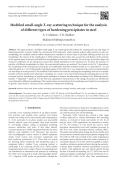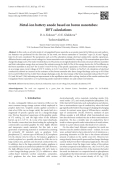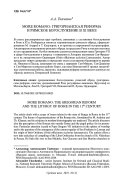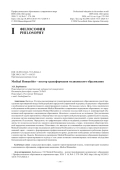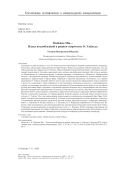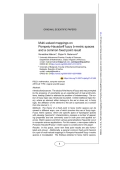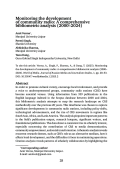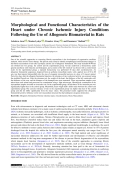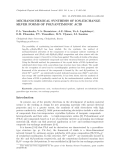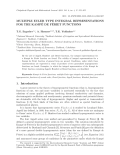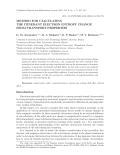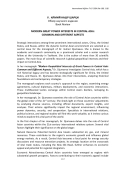This paper presents a modified small-angle X-ray scattering (SAXS) method for analyzing the size and shape of hardening particles in steels. Unlike the conventional SAXS approach, which typically analyzes alloy particles of only one morphology, the modified method enables simultaneous evaluation of various types of particles differing in both size and morphology. The essence of the modification to SAXS method is that it takes into account the contribution of the intensity of the separate types of particles with different morphologies to the total true intensity. For each type of particles, shape and structural coefficients are set taking into account their spatial distribution in the analyzed area. To detect the presence of particles of different morphologies in alloys, the experimental patterns are analyzed. First, based on the I(q−n) dependence, the morphology of the existing types of particles was traditionally identified (cylinder / needle (n =1), plate / disk (n = 2), and ellipsoid / sphere (n = 3, 4)). Subsequently, individual regions of the SAXS curve were analyzed in the context of optimizing the size and shape of various particles. The modified SAXS method was tested for analyzing the morphology and size of cementite particles in ferrite-pearlite steel subjected to annealing. As a result, it was shown that during the annealing process of steel, cementite particle morphology in pearlite grains undergoes a stepwise transformation according to the following scheme: lamellar → ellipsoidal → spherical. For the first time, quantitative characteristics of the change in particle size distribution were obtained for different morphologies. The transformation of cementite particle morphology was found to be accompanied by growth, which leads to a decrease in the contribution of dispersion hardening.
In this work, an ab initio study of a triangulated boron nanotube as an anode material for lithium-ion and sodium-ion batteries was performed for the first time. In the work, two boron nanotubes of “armchair” type (21, 0) and “zigzag” type (14, 0) were considered. The parameters such as Li / Na adsorption energy, electrical conductivity, specific capacitance, diffusion barriers and open-circuit voltage in a boron nanotube were calculated for varying Li / Na concentration upon three charge / discharge cycles. The study revealed that: a) Li / Na atoms are strongly bonded to the atomic structure of boron nanotube and their adsorption energy does not exceed the cohesive energy for bulk Li / Na; b) the energy barrier for Li / Na diffusion in the boron nanotube is 26.2 meV for Li and 17.0 meV for Na; c) the specific capacitance of a boron nanotube is 619.8 mAhg−1 at an average open circuit voltage of 0.70 V (relative to Li / Li+) and 0.66 V (relative to Na / Na+); d) calculation of electrical conductivity showed an increase in the resistance of the boron nanotube after three charge / discharge cycles up to 931 Ohm for Li and 632 Ohm for Na; e) after three charge / discharge cycles, the total energy of the boron nanotube reduced by 273 meV (Li) and 364 meV (Na) indicating an improvement in the equilibrium state after cycling. Analysis of the results confirms that triangulated boron nanotube is a very promising anode material for lithium-ion and sodium-ion batteries.
В статье рассматривается круг проблем, связанных с состоянием богослужения в Риме в XI в. Разбирается гипотеза «германизации» римского обряда, сформулированная М. Андриё и Т. Клаузером, и ее критика в современной историографии. Анализируются восприятие римского обряда за пределами Рима и папская политика по его продвижению. Особое внимание уделяется инициативам папы Григория VII в сфере богослужения и вопросу о появлении в Латеране каноников Сан-Фредиано и их литургического Ординария (Ordo officiorum ecclesiae Lateranensis). Автор предлагает новую датировку и определяет место составления Ординария из церкви св. Николая в Пассау, доказывая его связь с церквами Сан-Микеле, Сан-Джакомо и Сан-Мартино в римском районе Борго, где папа Иннокентий II провел масштабные строительные работы, вероятно, задумывая реформу ватиканского капитула по образцу капитула Латеранской базилики.
Введение. В статье рассматривается гуманитаризация медицинского образования как способ преодоления противоречий между биомедицинской парадигмой современной медицины, медицинского образования и необходимостью развития пациенто-ориентированного подхода.
Постановка задачи. Цель статьи заключается в обосновании необходимости включения Medical Humanities в современное медицинское образование, что предполагает конкретизацию понимания Medical Humanities и уточнение последствий отказа от доминирующей объективистской парадигмы в медицинском образовании.
Методика и методология исследования. Для достижения поставленной задачи применяются общенаучные методы исторической реконструкции, сравнительного анализа, отдельные методы компаративистского анализа, элементы индуктивных рассуждений, а также анализ правовых документов.
Результаты. Определено, что цифровизация в области медицины усиливает биомедицинскую парадигму, что не всегда соотносится с пациенто-ориентированным подходом, а также с изменением общетеоретической парадигмы понимания человека. Обосновано, что выходом из сложившейся ситуации является включение Medical humanities в подготовку медицинских работников. Необходимость этого связана с пересмотром взаимоотношений «врач – пациент», формированием профессиональной идентичности медицинского работника, формированием «сострадательных ценностей» «просвещенного врача», развитием необходимых когнитивных навыков и многим другим.
Выводы. Включение и расширение Medical Humanities в медицинском образовании формирует навыки пациенто-ориентированного подхода и тем самым позволяет минимизировать негативные последствия биомедицинской парадигмы современной медицины.
Актуальность работы связана с тем, что анализ русских персонажей в мировой художественной литературе, безусловно, представляет определенный научный интерес. Целью исследования является раскрытие того, как образы героинь двух первых пьес О. Уайльда – Веры Сабуровой и герцогини Падуанской – воплощают вдохновленный творчеством Д. Алигьери сакральный идеал мадонны (возлюбленной-госпожи). Для этого на материале «Новой жизни» Д. Алигьери выделены 4 основных признака: «Сакральность», «Вечность», «Нравственная чистота», «Благородство (включая Любовь-милосердие)». Проведен качественный и количественный анализ примеров их репрезентации в образах Веры Сабуровой и герцогини Падуанской. Установлено, что в ранней драматургии О. Уайльда женщина является своего рода ангелом-хранителем (проводником) между мужчиной и Богом. Ее сострадание к герою перерастает в инстинктивную материнскую нежность и самоотверженную любовь, что показывает способность на глубокую преданность. В исследовании сделан вывод о том, что образы русской крестьянки Веры Сабуровой и падуанской герцогини Беатриче могут рассматриваться как две специфические интерпретации вдохновленного поэтикой Д. Алигьери идеала мадонны. Миссией и экзистенциальной функцией данного идеала является сохранение и укрепление связи между Сакральным, Вечным, Нравственно Чистым и искусством художника, его мировоззрением. В работе вводится в научный оборот понятие русская мадонна О. Уайльда. Под этим определением подразумевается семантически насыщенный образ Веры Сабуровой, в котором вдохновленный поэтикой Д. Алигьери идеал возлюбленной-госпожи органично сочетается с ментальными чертами женских портретов из русской истории, народной культуры и литературы (произведений И. С. Тургенева, Ф. М. Достоевского, А. С. Пушкина, Н. А. Некрасова) современного О. Уайльду века. Вероятно, автор познакомился с русской литературой еще в ранней юности благодаря своей матери Леди Уайльд (Сперанца), которая переводила на английский язык стихи А. С. Пушкина. Работа открывает перспективы для дальнейшей переоценки места Веры Сабуровой в художественном мировоззрении автора. Исследование позволяет расширить представления о влиянии русской культуры на мировую художественную литературу.
Introduction/purpose: The study of the theory of fuzzy sets was prompted by the presence of uncertainty as an essential part of real-world problems, leading Zadeh to address the problem of indeterminacy. The notion of fuzzy logic was introduced by Zadeh. Unlike traditional logic theory, where an element either belongs to the set or does not, in fuzzy logic, the affiliation of the element to the set is expressed as a number from the interval [0, 1].
Methods: The theory of a fixed point in fuzzy metric spaces can be viewed in different ways, one of which involves the use of fuzzy logic. Fuzzy metric spaces, which are specific types of topological spaces with pleasing ”geometric” characteristics, possess a number of appealing properties and are commonly used in both pure and applied sciences. Metric spaces and their various generalizations frequently occur in computer science applications. For this reason, a new space called a Pompeiu-Hausdorff fuzzy b-metric space is constructed in this paper. Results: In this space, some new fixed point results are also formulated and proven. Additionally, a general common fixed point theorem for a pair of multi-valued mappings in Pompeiu-Hausdorff fuzzy b-metric spaces is investigated. The findings obtained in fuzzy metric spaces, such as those discussed in the article of Shen, Y. et al. (2012. Fixed point theorems in fuzzy metric spaces. Applied Mathematics Letters, 25, pp.138-141), are generalized by the results in this paper, and additional specific findings are produced and supported by examples.
Conclusions: The study of denotational semantics and their applications in control theory using fuzzy b-metric spaces and Pompeiu-Hausdorff fuzzy b-metric spaces will be an important next step.
In order to promote cultural variety, encourage local involvement, and provide a voice to underrepresented groups, community radio stations (CRS) have become essential venues. Using information from 339 publications in the English language indexed in the Scopus database between 2000 and 2024, this bibliometric analysis attempts to map the research landscape on CRS methodically over the previous 20 years. This timeframe was chosen to capture significant developments in community radio stations, including policy shifts, technological advancements, and the rise of CRS movements in regions like South Asia, Africa, and Latin America. The analysis pinpoints important patterns in the field’s publication output, research hotspots, significant writers, and foundational publications. The data shows a consistent rise in scholarly interest, especially concerning the contribution of CRS to media democratization, community empowerment, and social transformation. A thematic analysis reveals recurrent research themes, such as CRS’s role as an alternative medium, how it affects local development, and the difficulties it faces in maintaining operations. Citation analysis reveals patterns of scholarly collaboration by highlighting the most significant publications and the growth of research networks. This study highlights how CRS has influenced the media environment and how they might support community-based projects. This work advances theoretical knowledge of CRS’s development and continued significance by thoroughly analyzing the scholarly discourse on the subject.
One of the scientific approaches to correcting fibrotic myocardium is the development of regenerative medicine methods, which involve tissue therapy. The present study aimed to identify morphological and functional changes in the fibrous myocardium of rats after cryoinjury and the use of allogeneic biomaterial. The study included 80 Wistar rats divided into two groups, the control and the experimental group. All rats underwent a thoracotomy under general anesthesia with Xylazine and Zolazepam, and a section of the left ventricle was frozen with a cooled metal stylet. In the experimental group, a repeated thoracotomy was performed 45 days after cryodestruction. An allogeneic biomaterial suspension, dispersed from an acellular extracellular matrix with a particle size of 50 to 80 μm, was then injected intracardially into the area of cryogenic myocardial necrosis at a dose of 3 mg per animal. Forty-five days after the allogenic biomaterial injection, the tolerance of rats to physical activity was assessed using the modified Porsolt test. After the tolerance test, the weight of the heart, the thickness of the left ventricular wall, the thickness of the scar, and the diameter of the damaged area were measured. Three myocardium samples were taken from each animal and processed for examination using a light microscope. Histological examination of the myocardium samples revealed an avascular scar. In the experimental group, the thickness of the muscular part was significantly higher than in the control group. Meanwhile, heart weight didn’t differ much between the control and experimental group. The exercise tolerance of rats in the experimental group was higher than that of the control group and did not differ significantly from the intact values. The presented results supported the allogeneic biomaterial’s positive influence on the rats’ myocardium structure that had undergone cryogenic destruction.
The possibility of synthesising ion-substituted forms of hydrated silver antimonates Ag2γH2-2γSb2O6·2H2O has been studied. For the synthesis, the method of mechanochemical activation of the components of an inorganic mixture consisting of polyantimonic acid (PAA) with H2Sb2O6·2H2O composition and silver nitrate with the concentration range (γ) from 0.0 to 1.0 has been applied. The results of studies of the phase composition of the synthesized compounds and their structural features are presented. Using the Rietveld method, the parameters of the crystal lattice of PAA hydrated ionsubstituted silver forms with a pyrochlore-type structure have been refined. The model for the occupation of metal ions by crystallographic positions has been proposed: the framework of the structure of the compounds is formed by 16c- and 48f -positions, in which Sb5+ and O2- are statistically located; hydrated oxonium ions (H3O+) and silver ions occupy 16d- and 8b-positions respectively. It has been shown that the synthesis of silver forms of PAA is preferably carried out by the mechanochemical synthesis, which results in the complete substitution of proton groups by silver ions in the structure of the compounds.
By the aid of Appell, Humbert and Bessel functions, the integral representations for a Kamp´e de F´eriet function are found. The validity of integral representations for a Kamp´e de F´eriet function of general form are proved. Conditions, under which these representations are expressed in terms of products of two generalized hypergeometric functions are found. Examples, in which the integral representation of the Kamp´e de F´eriet function containing Appell, Humbert or Bessel functions, are identified.
In this work, the contribution of the free electron gas subsystem to the total entropy change during the phase transition in La(Fe, Co)13-xSix compounds has been evaluated. This estimation has been carried out using experimental data on the measurement of transport properties, in particular the Seebeck and Hall effects. In this work we have also analysed possible errors in the calculation of the carrier concentration in ferromagnets based on the results of measurements of the normal Hall coefficient. It was found that in the compounds studied it is necessary to take into account the contributions of magnetoresistance and paraprocess when calculating R0.
Doktor Gulnor Djumaeva monografiyasi uchun Markaziy masala sifatida uchta taniqli xalqaro aktyorlar-Xitoy, AQSh va Rossiyaning dinamik Markaziy Osiyo muhiti doirasidagi strategik o’zaro aloqalari tanlangan. U akademik va ilmiy jamoatchilikka Toshkentdagi universitetning taniqli olimi va katta ilmiy xodimi sifatida tanilgan. 30 dan ortiq ilmiy ishlar muallifi. Ilmiy tadqiqotlarning asosiy yo’nalishi global geosiyosiy manfaatlar va ularning Markaziy Osiyoga ta’siri hisoblanadi.
